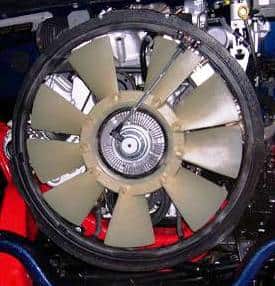The engine cooling fan
Many vehicles now have electric cooling fans that do not operate until necessary, when the engine coolant temperature climbs above a certain point. The changeover to electric cooling fans essentially came about for two reasons. One is simply packaging, because of front wheel drive (FWD) vehicles with transversely mounted engines.
Of course, the radiator must remain at the front of the vehicle so air can pass through it, but in FWD vehicles, the front of the engine faces the side of the car. “Old style” fans were driven off belts and pulleys mounted at the front of the engine; this is not feasible for a FWD car.
The second reason for the switch to electric cooling fans is efficiency. The use of electric fans can provide better fuel economy, as the fan does not operate at all times. This reduces the overall load on the engine during most driving conditions. This is why even many rear wheel drive (RWD) vehicles now use electric cooling fans.
However, many RWD vehicles (especially trucks) still use belt driven engine cooling fans, and most of these are equipped with a device called a thermostatic fan clutch. The thermostatic fan clutch allows the fan to spin with reduced force when full cooling demand is not needed. This also helps reduce load on the engine, which improves fuel economy.
Things that can go wrong with engine cooling fans
Electric cooling fans are generally reliable, but sometimes may fail to activate due to an inoperative or defective thermostatic switch, sensor or relay. This may cause the engine to overheat. Diagnosing a failure of this type can sometimes be time consuming, and also require special electronic diagnostic tools.
Thermostatic fan clutches can and do simply wear out over a period of time. This problem may not even be noticeable however, until the vehicle is subjected to some type of severe operating condition, such as towing, driving in extremely hot weather, etc., as the fan still spins, even with a defective or marginally operating clutch, just not as forcefully as it should. Your service technician can perform tests to determine if your fan clutch is operating properly.
extremely time consuming, and therefore costly, due to the amount of labor involved.
When having your mobile A/C system professionally serviced, insist on proper repair procedures and quality replacement parts. Insist on recovery and recycling so that refrigerant can be reused and not released into the atmosphere.
You can E-mail us at macsworldwide@macsw.org or visit http://bit.ly/cf7az8 to find a Mobile Air Conditioning Society repair shop in your area. Visit http://bit.ly/9FxwTh to find out more about your car’s mobile A/C and engine cooling system.


Can you tell me anything about why the fan blades in the picture are not evenly spaced?